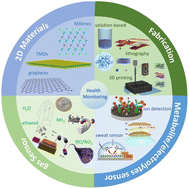Wearable chemical sensors based on 2D materials for healthcare applications
Abstract
Chemical sensors worn on the body could make possible the continuous, noninvasive, and accurate monitoring of vital human signals, which is necessary for remote health monitoring and telemedicine. Attractive for creating high-performance, wearable chemical sensors are atomically thin materials with intriguing physical features, abundant chemistry, and high surface-to-volume ratios. These advantages allow for appropriate material-analyte interactions, resulting in a high level of sensitivity even at trace analyte concentrations. Previous review articles covered the material and device elements of 2D material-based wearable devices extensively. In contrast, little research has addressed the existing state, future outlook, and promise of 2D materials for wearable chemical sensors. We provide an overview of recent advances in 2D-material-based wearable chemical sensors to overcome this deficiency. The structure design, manufacturing techniques, and mechanisms of 2D material-based wearable chemical sensors will be evaluated, as well as their applicability in human health monitoring. Importantly, we present a thorough review of the current state of the art and the technological gaps that would enable the future design and nanomanufacturing of 2D materials and wearable chemical sensors. Finally, we explore the challenges and opportunities associated with designing and implementing 2D wearable chemical sensors.

- This article is part of the themed collections: Recent Review Articles, U.S National Nanotechnology Day 2023 and Nanoscale 2023 Emerging Investigators


 Please wait while we load your content...
Please wait while we load your content...